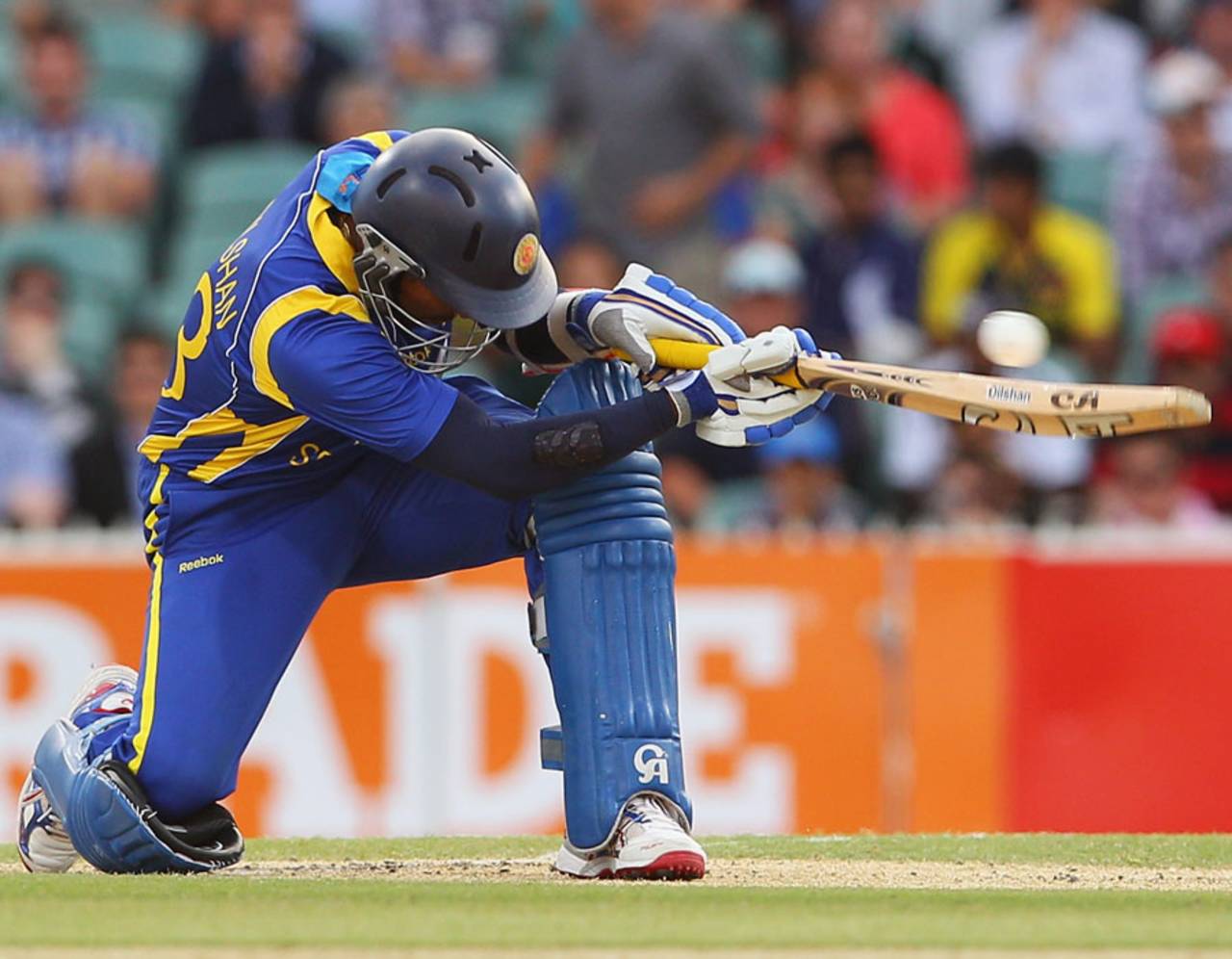Is cricket ripe for a tactical overhaul?
Like football, can it be reinvented by master tacticians, or is it too individual to be shaped?

The Dilscoop: a mandatory skill for all top-order batsmen in limited-overs cricket • Getty Images
Ironically, one of the greatest tactical innovations was short-lived in practice and eternally infamous. Douglas Jardine's leg theory demanded that England's bowlers aim at the bodies of Australian batsmen, with fielders clustered behind square on the leg side. Developed to marginalise one man, Don Bradman, Bodyline is almost unique in cricket's history. Bradman averaged "only" 56, England won the series - at a high cost, in terms of reputation. But the moral furore obscured the tactical ingenuity. As a challenge to readers, can anyone think of a more decisive example of top-down thinking in the history of cricket? Leg theory, of course, was promptly banned - a signal fate, perhaps, for the influence of abstract thinking on the cricket pitch.
Fast bowling inspired another terrifying innovation. We are now used to the idea of picking the four best bowlers, whatever their actions, but it was once revolutionary. In backing his four quick men to dominate any opposition, whatever the surface, Clive Lloyd was breaking with an accepted (albeit wrong) tenet of conventional wisdom: that all bowling attacks must have variety. Not when they are as good as my guys, answered Lloyd. He was right, of course. Lloyd cemented the idea that the structure of a team ought to change to accommodate the talent available.
Just as football has gradually kicked out the "playmaker" who refuses to track back and join the defensive alignment, so cricket has lost patience with great batsmen and bowlers who decline to field. Fielding, once merely a defensive mode, has become a weapon of attack, a way of making batsmen feel hemmed in, surrounded, under pressure.
Martin Crowe pioneered two great tactical innovations at the 1992 World Cup. First, Mark Greatbatch opened the batting, with a licence to attack from the first ball. Secondly, offspinner Dipak Patel took the new ball. The impact was immediate. Pinch-hitting had become a permanent feature by the time Sri Lanka won the following World Cup. And the advent of T20, which has proved the value of slow bowling against aggressive batting, confirmed that Crowe's fundamental insight was correct: taking pace off the ball often makes it harder for batsmen to add pace to the ball.
Cricket is made up of discrete, isolated duels. At the moment the ball is bowled, the rest of the batting side is essentially irrelevant: only one man counts
Steve Waugh's commitment to scoring four runs an over in Test cricket was a rare example of a captain going public about his principles. So there was a double aspect to his confidence - first, the conviction that his batsmen were good enough to do it; second, the confidence that he could announce the tactic before the game began.
In the 1990s, Franklyn Stephenson became famous for his celebrated back-of-the-hand slower ball. Now, a slower ball - more accurately, a range of slower balls - is a required skill for any fast bowler who wants to play ODI and T20 cricket. Rarity has become necessity.
Two innovations led to a third. First, the helmet allowed batsmen to become far less concerned about the risk of getting hit; second, the need for batsmen to maximise boundary opportunities during fielding restrictions. Solution: the Dilscoop. A shot of breathtaking daring, until recently unimaginable, is now an essential skill for a modern top-order batsman in white-ball cricket.
Where the law was changed to stop Bodyline, the law was changed to keep the doosra. The legality of some doosras remains controversial, but it is a central weapon in today's game. If your team can't bowl doosras, at least make sure you can pick them.
Here things become tricky. By reviving a dying art, Warne certainly revolutionised the sport. But should that be classed as a tactical innovation? In the same way, it is hard to know how to categorise Adam Gilchrist's role in the development of the wicketkeeper-batsman. Both Warne and Gilchrist changed and profoundly enhanced the history of cricket. But they did it just by being themselves. So was their greatness personal rather than theoretical?
Ed Smith's latest book is Luck - A Fresh Look at Fortune. @edsmithwriter